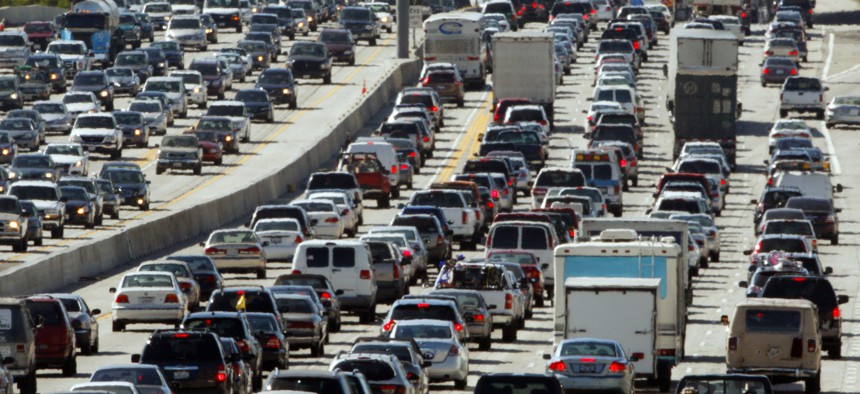As the Pandemic Subsides, Traffic is Creeping Back

This May 28, 2010, file photo shows traffic jammed in both directions on Interstate 405 on the Westside of Los Angeles. AP Photo/Reed Saxon
A report from StreetLight Data found the average daily number of vehicle miles traveled was down 15% overall in 2020 but as of March has started to return to normal levels.
Driving was down in 2020 compared to 2019 due to the coronavirus pandemic, but rush hour could be making a comeback this year, according to a new report by a data analytics company.
The average daily number of vehicle miles traveled (VMT) across the United States was down by 15% overall in 2020, according to a report by StreetLight Data.
In the last several months, traffic has shown signs of a rebound as vaccines became widely available, workers returned to offices, and social distancing regulations were relaxed.
The average number of daily VMTs was down by 12% nationwide in February 2021 compared to February 2020, the last month before pandemic-related restrictions began to affect travel. But data from March 2021 shows VMTs that month were 2% higher than travel in February 2020. Nationwide, the average daily number of VMTs in March 2021 was 20% higher than in March 2020, when many states began to enact travel restrictions.
“Although states varied their reopening policies and timelines, the one-year mark denoted a clear ‘return to normal’ for the U.S. overall,” the report states.
StreetLight Data analyzes traffic patterns by using location data collected anonymously from cellphone applications and connected car navigation systems to understand where and when people travel.
The data published in the most recent report, released this month, shows that not only is traffic rebounding but typical rush hour traffic patterns are starting to return in some cities, said Martin Morzynski, StreetLight’s vice president of marketing.
The findings follow on the company’s October report, which found that during the early months of the pandemic the typical spike in morning rush hour traffic was suppressed and evening rush hour spread out into the afternoon.
While workers may be divided over whether or not they want to return to the office, it’s unlikely that anyone is craving the return of rush-hour congestion.
For cities that want to avoid a complete return to normal—rush-hour traffic included— Morzynski suggests there is room for transportation planners to work with local partners to address transit challenges. Cities could work with universities or chambers of commerce to suggest staggered start times for major employers or schools in order to alleviate the rush-hour return, he said.
Private companies, educational institutions and cities can “broker arrangements that will prevent everyone from being on the road at the same time,” Morzynski said. “But it has to be a collaboration between agencies and employers.”
Travel has not rebounded evenly across the country, and StreetLight notes some varied traffic patterns. Thirty-seven states saw an increase in the daily average of VMTs in March 2021 compared to February 2020. Only 12 states remained below the February 2020 averages.
Several major cities, including Washington, D.C., San Francisco, Dallas and Los Angeles, have continued to experience what StreetLight calls “peak spreading” in February 2021. While the cities still experience pronounced morning and evening traffic peaks, weekday traffic tends to build more gradually than in prepandemic times and spreads out over the afternoon.
StreetLight noted two exceptions in cities it analyzed: Tampa and Orlando.
The two Florida cities “were already returning to a more traditional daily traffic pattern by February this year,” the report states. “This is a warning sign that other cities may soon follow suit, as remote work gradually gives way to office commutes.”
Andrea Noble is a reporter with Route Fifty.
NEXT STORY: Baltimore takes a data-driven approach to targeting gun trafficking





